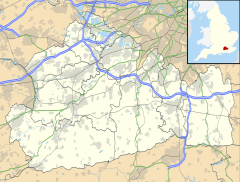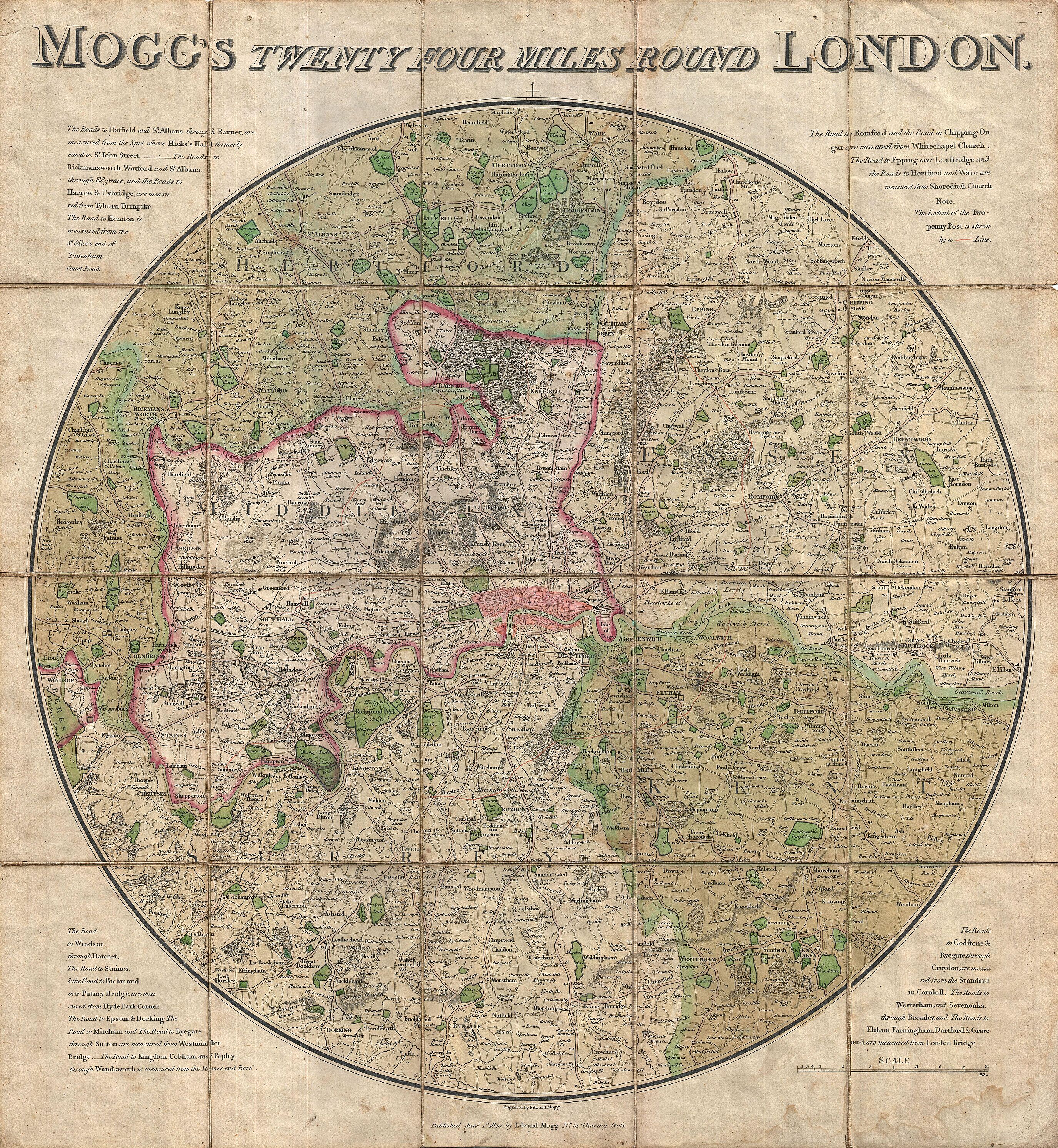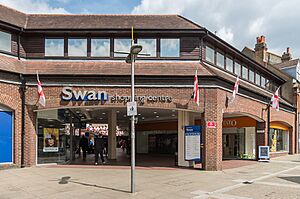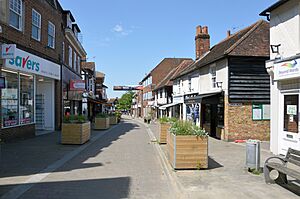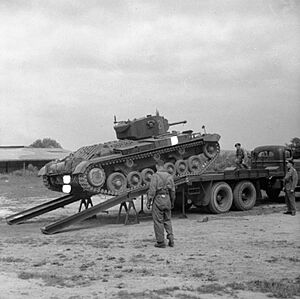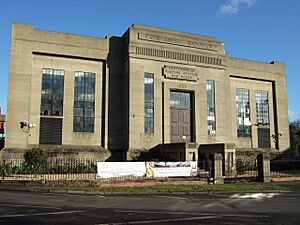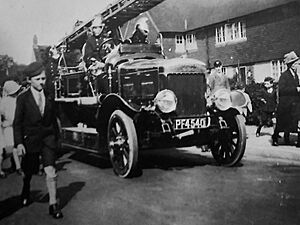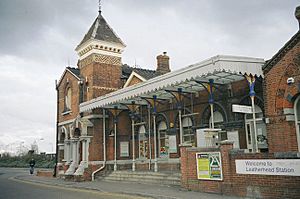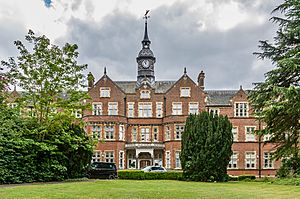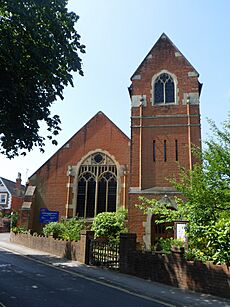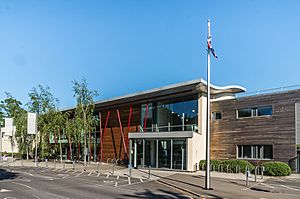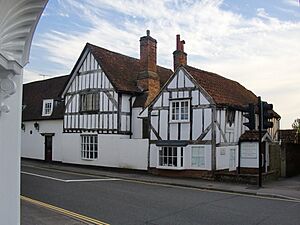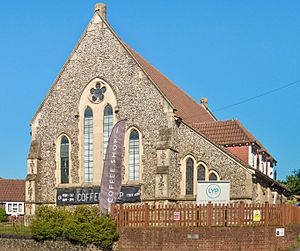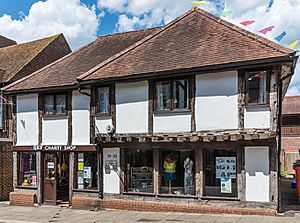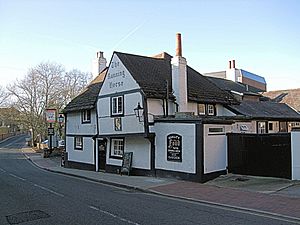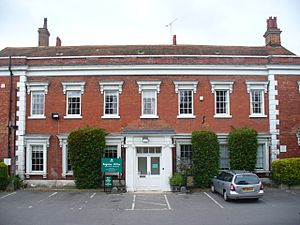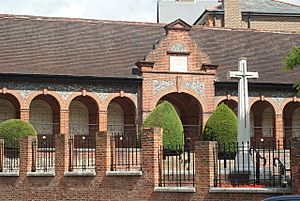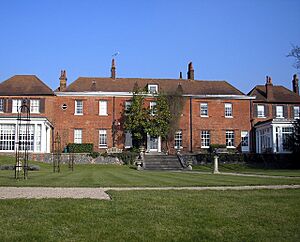Leatherhead facts for kids
Quick facts for kids Leatherhead |
|
|---|---|
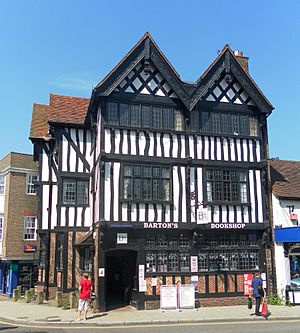 2 Bridge Street, Leatherhead |
|
| Area | 12.54 km2 (4.84 sq mi) |
| Population | 11,316 (2011 census) or 32,522 as to its Built-up Area which extends to Effingham |
| • Density | 902/km2 (2,340/sq mi) |
| OS grid reference | TQ1656 |
| • London | 17 mi (27 km) north |
| District |
|
| Shire county | |
| Region | |
| Country | England |
| Sovereign state | United Kingdom |
| Post town | Leatherhead |
| Postcode district | KT22 |
| Dialling code | 01372 |
| Police | Surrey |
| Fire | Surrey |
| Ambulance | South East Coast |
| EU Parliament | South East England |
| UK Parliament |
|
Leatherhead is a town in Surrey, England. It is about 17 miles (27 km) south of Central London. The town grew up next to a shallow part of the River Mole where people could cross easily. This crossing point is probably where the town got its name.
Leatherhead was a royal village during the late Anglo-Saxon period. It was first mentioned in the will of Alfred the Great in 880 AD. The first bridge over the River Mole might have been built around 1200. This was also when the town and its church started to grow.
For a long time, Leatherhead was mainly a farming town. It had a weekly market until the mid-Elizabethan era. In the 1700s, new turnpike roads were built. Then, in the 1800s, the railways arrived. These changes brought new people and helped the local economy grow. After the First World War, big factories like Ronson and Goblin Vacuum Cleaners opened in the town. Many groups helping disabled people also set up places for treatment and training. These included The Royal School for the Blind and Queen Elizabeth's Foundation.
By the end of the 1900s, factories in Leatherhead started to close. The town then began to attract companies that offered services, not products. Old factory areas became business parks, bringing in large companies like Esso and Unilever. In the early 1980s, the town centre was redeveloped. This included building the Swan Centre and making the main shopping area just for walkers. Some people blamed these changes for a drop in local shopping. In 2002, the BBC said Leatherhead had one of England's worst main streets. But by 2007, local newspapers described the town centre as "bustling."
Contents
- What's in a Name?
- Where is Leatherhead?
- A Look Back in Time
- Public Services
- Getting Around Leatherhead
- Learning in Leatherhead
- Places of Worship
- Arts and Entertainment
- Sports and Recreation
- Places to Visit
- Important Buildings and Landmarks
- Parks and Green Spaces
- Famous People from Leatherhead
- See also
What's in a Name?

The exact meaning of the name 'Leatherhead' is not fully known. Old spellings include Leodridan (from 880) and Leret (from 1086).
Most people think the name comes from Old English words. Lēode means 'people' and rida means 'a riding path or ford'. So, it might mean 'a public crossing point'.
Where is Leatherhead?
Location and Landscape
Leatherhead is in the middle of Surrey. It is about 17 miles (27 km) south of central London. The town is on the southern edge of the London Basin. The highest point in the area is Leatherhead Downs, which is 135 metres (443 ft) above sea level.
The main street, High Street, runs mostly from west to east. It was once part of the road from Guildford to Epsom. This road crossed the River Mole at the Town Bridge. The River Mole flows west of the town centre. It has carved a deep valley through the North Downs south of Leatherhead.
Understanding the Ground Beneath Us
Leatherhead is at the southern edge of the London Basin. Here, the chalk of the North Downs is permeable, meaning water can pass through it. This chalk then dips under the London Clay, which is impermeable, meaning water cannot pass through it easily.
This difference in rock types causes a high water table. This means that springs (places where water flows out of the ground) are found often along the boundary between the chalk and clay. Many settlements, like Ashtead, Fetcham, and Effingham, were built along this "spring line" in Anglo-Saxon times. These villages are connected to Leatherhead by the old Guildford to Epsom road.
A Look Back in Time
Early Days
The oldest signs of people living in Leatherhead are from the Iron Age. In 2012, during building work on Garlands Road, people found flint tools, a possible well, and two pits. These findings suggest the area was also used in the early Roman period. Traces of Iron Age farms and settlements have been found nearby at Hawks Hill and on Mickleham Downs.
An Anglo-Saxon settlement in Leatherhead likely started on the east side of the River Mole in the late 500s. A burial ground from the same time was found on the west side at Hawks Hill. Another cemetery was found in 1984 where the old Goblin factory used to be (now Esso offices). Digs there found the remains of at least 40 people. Items like knives, buckles, and necklaces suggest these were pagan burials.
From the mid-800s, Leatherhead was the centre of a royal vill (a royal estate). This area included Ashtead, Fetcham, and Bookham. The first time Leatherhead is mentioned is in Alfred the Great's will in 880. He left land at Leodridan to his son, Edward the Elder. By the 900s, Leatherhead had a minster church. The town was managed as part of the Copthorne Hundred (a type of old administrative area).
How Leatherhead Was Governed
Leatherhead's history in the Middle Ages is a bit complicated. The area was divided into several manors. The town is mentioned in the Domesday Book of 1086 as Leret. It was owned by Osbern de Ow, who reported to William I. The Domesday Book says it had one church and 40 acres of land, worth £1 a year.
South of the town was Thorncroft Manor. This manor was owned by Richard fitz Gilbert. To the north was Pachesham Manor, which was split into two parts. Over time, the manor of Pachesham became divided into smaller pieces. By the early 1600s, one part was known as Randalls Farm.
During the Tudor period, the local church's vestry (a church committee) took over running towns like Leatherhead. The vestry appointed a constable (a local police officer), kept a lock-up (a small jail), and organized a basic fire service. Until 1834, they also helped the poor and built a workhouse in 1808.
In the 1800s, new laws slowly took away these duties from the church vestry. The Poor Law Amendment Act 1834 put the workhouse under a board in Epsom. The Local Government Act 1888 gave many tasks to the new Surrey County Council. The Leatherhead Urban District Council (UDC) was formed in 1894. In 1972, the Local Government Act 1972 created Mole Valley District Council. This council combined the UDCs of Leatherhead and Dorking with most of the Dorking and Horley Rural District.
Getting Around: Transport and Communication
Leatherhead grew at a place where the River Mole could be crossed. This was where the north-south road (from Kingston to Dorking) met the east-west road (from Epsom to Guildford). The first bridge in Leatherhead might have been built around 1200.
It's not clear how much the River Mole was used for boats in the past. But in the early Middle Ages, small, shallow-bottomed boats could probably reach Leatherhead from the Thames for most of the year.
In 1755, Parliament allowed a turnpike road to be built between Epsom and Horsham, passing through Leatherhead. Turnpikes to Guildford and Kingston opened later. Stagecoaches, which had started running to London in the 1680s, became more frequent after the turnpikes were built. By 1838, coaches ran daily to Arundel, Bognor, and Worthing. They usually stopped at the Swan Inn. When the railway reached Epsom Town in 1847, long-distance coaches stopped. Horse-drawn omnibuses then took over local trips.
The first railway in Leatherhead opened on 1 February 1859. It was built by the Epsom and Leatherhead Railway Company. Trains initially ran to Epsom. From April 1859, services extended to London Waterloo. In August 1859, the London, Brighton and South Coast Railway (LBSCR) started trains from Leatherhead to London Bridge.
The railway line south from Leatherhead to Dorking opened in 1867. The old station in Kingston Road closed. Two new stations opened, one for LBSCR and one for LSWR. The LBSCR station, designed in a Gothic Revival style, is the one still used today. All railway lines through Leatherhead were electrified in 1925. The LSWR station closed in 1927.

The A24 bypass was built between 1931 and 1934. Young Street (part of the A246) was built by the Corps of Royal Canadian Military Engineers between 1940 and 1941. In October 1985, Leatherhead was connected to the UK motorway system when the M25 opened nearby.
Shopping and Business
Leatherhead was given the right to hold a weekly market and an annual fair in 1248 by King Henry III. The market probably took place where Bridge Street, North Street, and High Street meet. The market seems to have stopped in the mid-Elizabethan era. However, the annual fair continued.
The new turnpike roads and railways brought wealthier people to Leatherhead. Many of these newcomers had made money in London. By the start of the Victorian era, they began to change the local economy. Small, family-run businesses grew, making things like bricks, milled wood, tanned leather, and beer. In 1841, 18.5% of the town's people worked in farming. Forty years later, this number had dropped to 5.4%.
Larger industries came to Leatherhead in the early 1900s. In 1928, a rayon factory opened. Ten years later, the Goblin Vacuum Cleaners factory took its place. In the 1930s, a silk-making farm and an electrical cable factory also started. After the Second World War, Ronson, a US company making cigarette lighters, opened a factory. This factory closed in 1981, and a business park was built there.
The Ex-services Welfare Society bought Long House in Ermin Way after the First World War. They built a factory there to employ disabled veterans, making electrical items like electric blankets. In 1933, they opened a treatment centre. In 1981, Remploy bought the factory, making electrical and mechanical goods. The Remploy factory closed in 2007. The Ex-services Welfare Society, now called Combat Stress, still runs its treatment centre.
Large factories in Leatherhead didn't last long. As the 1900s went on, the town started to attract companies that offered services. Research groups like Leatherhead Food Research and Central Electricity Research Laboratories (CERL) were based here. Both left in the early 2000s. The Ronson and Goblin factories closed in the early 1980s. Their sites were redeveloped, with the Goblin site becoming the UK headquarters for Esso. The UK head offices of Unilever and Hyundai opened in Leatherhead in 2008 and 2020.
A big change to the town centre roads happened in the late 1970s and early 1980s. The Prince of Wales pub was knocked down in 1979. The Swan Centre, a covered shopping centre with a multistorey car park, was built there. At the same time, a one-way traffic system was created, and the High Street became a pedestrian-only area. By 1981, local shop owners and residents were complaining. They said the traffic changes caused fewer people to visit the shops. In 2002, BBC News said Leatherhead had one of the worst High Streets in the country. But by 2007, local newspapers reported that the town was "bustling with people, and packed full with an abundance of shops, entertainment facilities and job opportunities." This improvement was due to community efforts, including a new drama festival.
Homes and Houses
Leatherhead started to grow at the beginning of the 1900s. Its population increased from 4,694 in 1901 to 5,491 in 1911. New houses were built between 1900 and 1905 in areas like Fairfield and Kingston Roads.
The first council houses in the town were built by Leatherhead UDC in 1921. There were 59 houses in Poplar Road. Ex-servicemen and their families were given priority for these homes. In 1925, 90 more council houses were built in Kingston Road. Private housing also grew, including the St Mary's Road estate.
The Givons Grove estate, south of the town, was developed in the late 1920s and early 1930s. This area was once farmland. In 1919, it was bought by aircraft maker Humphrey Verdon Roe. It was sold to developers in 1927, who divided the land for housing.
After the Second World War, new homes were built north of the town centre. These replaced properties damaged by bombs.
Leatherhead During the World Wars
At the start of the First World War, soldiers from the Royal Fusiliers stayed with local families in Leatherhead. They trained at Randalls Farm. Later, 63 Belgian refugees arrived and stayed until the war ended.
People worried that the town's water supply might be poisoned. So, guards were placed at the waterworks. Local Scouts and Boys' Brigade members helped with this. Many local men joined the Dorking and Leatherhead Battalion of the Volunteer Training Corps. This group aimed to defend the area if there was an invasion. In October 1914, a Red Cross Hospital opened. It had 33 beds and was always full. It closed in 1919.
Leatherhead was again a military town in the Second World War. Troops from the Royal Corps of Signals stayed there in late 1939. A year later, Canadian soldiers began to arrive. From September 1939, children from London were evacuated to Leatherhead. The Royal School for the Blind was taken over by King's College Hospital. The cottage hospital opened in May 1940. By June, it was treating 78 members of the British Expeditionary Force who had been evacuated from Dunkirk. The Goblin factory made war supplies, like mine parts and camouflage netting.
The local Home Guard unit was formed in May 1940 with 200 recruits. They trained at the Drill Hall. An anti-tank obstacle was put at the east end of the High Street. The Home Guard was disbanded four years later when the threat of invasion passed.
Leatherhead was bombed twice during the war. The first attacks were from late 1940 to early 1941. On 27 August 1940, 20 bombs fell near Ashtead. The golf club's building was hit, but people in the shelter below were safe. In October, oil tanks near the waterworks caught fire from an incendiary bomb. The fires burned for over 24 hours. In March 1941, St Andrew's Catholic School was almost completely destroyed by a bomb. In the summer of 1944, 16 V-1 flying bombs landed in the Leatherhead area, including one at Thorncroft Manor.
Public Services
Utilities: Gas, Water, and Electricity
The town's gasworks were built in 1850 by the Leatherhead Gas Company. Gas was first produced in February 1851. It was mainly used for street lighting and some homes. Coal was brought by road until the railway opened in 1859. The Leatherhead gasworks closed in 1938.
Leatherhead's first public water supply started in 1884. A steam-powered pumping station was built in Waterways Road. It could pump 90,000 litres (20,000 imp gal) per hour to a reservoir. A second diesel-powered station was built in 1935 and later changed to electric power. The steam-powered works were taken down in 1992.
An electricity generating station opened in Bridge Street in 1902. It could generate 75 kW of power. By the time it closed in 1941, it could generate 2.2 MW. In 1926, Leatherhead was connected to the National Grid.
Emergency Services
Leatherhead Police Station was on Kingston Road. It closed in 2011. The building was later demolished. In 2021, the local police force is Surrey Police. The closest police station is in Reigate. The headquarters of the Police Federation of England and Wales is in Leatherhead.
The Vestry was in charge of the local fire service in the 1700s and early 1800s. The town's fire engine was kept in the church tower. In 1821, it moved to North Street, and a new fire station was built there in 1859. The first motor fire engine arrived in 1926. In 2021, the local fire authority is Surrey County Council. The fire service is Surrey Fire and Rescue Service. Leatherhead Ambulance Station is on Kingston Road. It is run by the South East Coast Ambulance Service.
Healthcare
The first hospital in Leatherhead opened in Clinton Road in 1893. It was a small cottage hospital with only seven or eight beds. It closed in 1902. A new hospital, the Queen Victoria Memorial Hospital (QVMH), opened on Epsom Road in 1905. It started with 6 beds and closed at the end of the Second World War.
Leatherhead Community Hospital, on Poplar Road, opened in 1940. It was built on land given by Charles Leach. It started with 40 beds. In 2014, the in-patient wards closed to improve outpatient services. The NHS still owns the hospital, but many services are run by CSH, a not-for-profit group. The X-ray department is run by the Epsom and St Helier University Hospitals NHS Trust.
The closest hospital with an A&E (Accident and Emergency) is Epsom Hospital, about 5.3 km (3.3 mi) away. As of 2021, Leatherhead has two GP (doctor's) practices.
Getting Around Leatherhead
Train Travel
Leatherhead railway station is west of the town centre. It is managed by Southern. Trains from here go to London Victoria (via Sutton), London Waterloo (via Wimbledon), Horsham (via Dorking), and Guildford (via Bookham).
Bus Services
Several bus routes serve Leatherhead. Route 21 goes between Epsom, Leatherhead, and Crawley. Route 408 goes between Epsom and Cobham. Route 465 connects Kingston upon Thames to Dorking via Leatherhead. Route 478 goes to Guildford. Route 479 goes from Epsom to Guildford via Leatherhead.
Walking Trails
Leatherhead station is the start of the Mole Gap Trail. This path goes south through Norbury Park to Dorking station.
Learning in Leatherhead
Old Schools
The first record of a school in Leatherhead is from 1596. It was a charity school for ten boys, probably held in the church tower. By 1712, it also taught eleven girls.
In 1838, a boys' school opened in Highlands Road. A girls' school followed a year later. These were National schools, funded by local donations.
Local Schools Today
Leatherhead Trinity School opened in 2010. It was formed by combining three older schools. Trinity School is a primary school for children up to age eleven.
St Peter's Roman Catholic Primary School started in 1947. Its current building opened in 1958.
Therfield School began in 1913 as the County Upper Mixed Senior School. It moved to Dilston Road in 1953 and was renamed in 1964.
St Andrew's Catholic School was founded in 1935 by five nuns. The main building was built in 1952. In 1971, it became a school for both boys and girls.
West Hill School is a special school for children with learning needs. It moved to Leatherhead in 1963. Fox Grove School, another special needs school, opened in 2021 and will move to Leatherhead in 2022.
Private Schools
Downsend School moved to Leatherhead in stages between 1918 and 1940. It expanded in the late 1970s and 1980s. In 2017, the school announced plans for a new study centre for students taking GCSEs.
St John's School was founded in 1851 and moved to Leatherhead in 1872. It was first for sons of poor clergymen. In 1989, girls were accepted into the sixth form. The school became fully coeducational in 2012. Several parts of the school are Grade II listed (protected buildings).
The Royal School for the Blind (SeeAbility)
The School for the Indigent Blind started in London in 1799. In 1900, it bought land in Leatherhead. A new building opened in 1904, able to hold up to 250 students. George V gave it royal support in 1911, and it became the Royal School for the Blind.
By the mid-1930s, the school focused on teaching practical skills in workshops. During the Second World War, King's College Hospital used the building. In the early 2000s, the main school building was sold and turned into apartments, now called Lavender Court. The charity changed its name to "SeeAbility" in 1994. It now focuses on community support rather than residential education.
Places of Worship
St Mary and St Nicholas Church
The Church of St Mary and St Nicholas was likely built as a chapel for Thorncroft Manor. Its oldest parts are from around 1080. It might have become the main parish church in the early 1100s. The church was greatly expanded in the 1240s. Much of the chancel (the area around the altar) is from the early 1300s.
The tower was built around 1500. It used to have a tall spire, which was blown down in the Great storm of 1703. Major renovations happened in the late 1800s. Recent work (2018-2020) found several vaults (underground rooms) beneath the floor.
The churchyard has the war graves of 12 British service members from the First and Second World Wars.
Catholic Church of Our Lady and St Peter
The Catholic Church of Our Lady and St Peter was built in 1923. Part of the funding came from newspaper owner Sir Edward Hulton. The Gothic Revival building was designed by Joseph Goldie. The stained glass windows were added in the 1930s. The Stations of the Cross were carved from Caen stone by sculptor Eric Gill.
Methodist Church
John Wesley, who started Methodism, visited Leatherhead only once. On 23 February 1791, he preached his last sermon in a house on Bull Hill, a week before he died. A significant Methodist community didn't form until the mid-1800s. The first church, the "Iron Chapel" (made mostly of metal), was built in 1887. By 1891, the number of people attending grew to over 400. Two years later, the current brick church was built.
Disciples Church
The Disciples Church is part of the Calvary Chapel Association of evangelical churches. It was formed in 2007 and got its current name in 2012. It meets at the Woodlands School.
Arts and Entertainment
Artistic Impressions
J. M. W. Turner (1775–1851), a famous artist, painted scenes of Leatherhead. His watercolour Leatherhead, Surrey, from across the River Mole was likely made in 1797. It was sold for £35,000 in 2014. Other artists who worked in the town include John Hassell and John Varley.
Public art in the town includes metalwork at the King George V Memorial Park.
Theatres and Cinemas
The first movie was shown in Leatherhead at the Leatherhead Institute in October 1898. The Victoria Hall, built in 1890, also showed films. By 1914, the Victoria Hall became the Grand Theatre, a cinema with 550 seats. It later became known as the Ace Cinema.
In 1949, the Ace Cinema was turned into a 300-seat theatre. A year later, the Leatherhead Theatre was created. This theatre operated until 1969.
The Thorndike Theatre, in Church Street, opened in 1969. It was named after actress Sybil Thorndike. It was designed in a modernist style. The theatre closed in 1997 due to financial problems. It reopened in 2001 as a part-time theatre, cinema, and community space. The annual Leatherhead Drama Festival, for amateur theatre groups, started there in 2004.
Literary Connections
Leatherhead is mentioned in the novel The War of the Worlds by H. G. Wells, published in 1897. In the story, the town is completely destroyed by Martians.
The Sherlock Holmes short story "The Adventure of the Speckled Band" is partly set near Leatherhead. Holmes and Watson travel there by train from Waterloo station. This story was published in 1892. The 1984 video game Sherlock is also partly set in Leatherhead.
Musical Notes
The Leatherhead Operatic Society started in 1904. They performed at the Victoria Hall until 1922. Since 1970, they have performed at the Thorndike Theatre and Leatherhead Theatre.
The Leatherhead Choral Society (LCS) was formed in 1907. They usually give concerts in summer and early December.
The Leatherhead Orchestra started around 1958. Since 2015, they have given three concerts each year.
The Leatherhead Town Band was founded in 1887. It stopped activities during the World Wars. In 1974, it changed its name to the Mole Valley Silver Band. The band performs regularly in Leatherhead and Dorking.
The band John's Children, which included Marc Bolan, formed in Leatherhead in 1963. They sometimes played at the Chuck Wagon Club.
Surrey Sound recording studio was set up in 1974 by producer Nigel Gray. Many famous bands recorded there, including the Police, Siouxsie and the Banshees, and Rick Astley. The studio was sold in 1987.
Robyn Hitchcock mentions Leatherhead in his song "Clean Steve."
On Screen
Leatherhead has been mentioned in films and TV shows. The film I Want Candy (2007) is partly set in the town. Brooklands College was used as the filming location for "Leatherhead University."
Monty Python's Flying Circus refers to Leatherhead in a sketch. The TV show That Mitchell and Webb Look also made a joke about Leatherhead. The house used as Arthur Dent's home in The Hitchhiker's Guide to the Galaxy TV series is in Leatherhead.
Sports and Recreation
Leisure Centre
The Leisure Centre opened in 1975. It was expanded in the 1980s. In 2011, it had a £12.6 million renovation and extension. The upgraded centre has a new gym, aerobics studio, sauna, and play areas. In 2023, a report said that 750,000 visits were made to the centre each year.
Cricket
Cricket has been played in Leatherhead since at least 1840. The Leatherhead Cricket Club was founded in 1850. It moved to Fetcham Grove in the 1930s.
Football
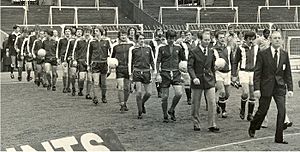
Leatherhead F.C., known as "The Tanners," was formed in 1946. It was a merger of two existing clubs, Leatherhead Rose and Leatherhead United. The new club made Fetcham Grove its home ground.
In the late 1940s and early 1950s, they were champions of the Surrey County Senior League for four years in a row. In 1969, the team won three cups. They reached the semi-finals of the FA Amateur Cup in 1971 and 1974. The Tanners gained national attention in the 1974–75 season. They played against First Division team Leicester City in the FA Cup Fourth Round. In the 2017–18 FA Cup, they reached the second round.
Golf
The Leatherhead Club started as the Surrey Golf Club. It got its current name in 1908. The 18-hole course was designed by Peter Paxton. The Prime Minister, Arthur Balfour, played there in 1907. Alf Perry joined as Club Professional in 1928. Seven years later, he won the 1935 Open Championship. The clubhouse was damaged by bombs during the Second World War. The building of the M25 motorway in the late 1970s changed parts of the course.
The 18-hole Tyrells Wood Golf Course was designed by James Braid in 1922. It opened two years later.
Pachesham Golf Centre opened in 1989 as a nine-hole course. It was changed to a six-hole course in 2014. The centre has a 28-bay, floodlit driving range, which is the longest in Surrey.
Beaverbrook golf course, south of Leatherhead, opened in 2016. Its construction was opposed by local residents and environmental groups.
Places to Visit
Bocketts Farm
Bocketts Farm covers 52 hectares (128 acres) southwest of the town. The farmhouse and the timber-framed granary are from around 1800. They are Grade II listed (protected buildings). The Gowing family bought the farm in 1990 and opened it to the public in 1992.
Leatherhead Museum
Leatherhead Museum opened in 1980. It is run by the Leatherhead & District Local History Society. It has many historical items and shows the town's history from its beginnings to today. Hampton Cottage, where the museum is located, dates from before 1682.
River Mole Nature Reserve
The River Mole local nature reserve is a 23.3-hectare (58-acre) protected area. It runs along the river banks from Young Street to Waterway Road. It was named a nature reserve in 2005 because of its many different plants and animals.
Important Buildings and Landmarks
All Saints' Community Hub
All Saints' Church on Kingston Road was built in 1889. It was designed by architect Arthur Blomfield. It was built to serve new houses north of the town centre. In 1982, the church was partly converted into a community space, while keeping a worship area. In 2005, the main part of the church became a Youth Project Café called "B Free." In 2014, the Leatherhead Youth Project started a new social enterprise called "AllSaints" there. This project helps young people who are not in education, employment or training to gain skills and jobs.
Cherkley Court
Cherkley Court was built around 1870. It was largely rebuilt after a fire in 1893. In 1910, it was sold to Max Aitken, 1st Baron Beaverbrook, owner of the Daily Express. After his son's death in 1985, it was owned by the Beaverbrook Foundation. In 2011, it was bought by private investors. Despite local opposition, the house was turned into a luxury hotel, spa, and golf course, opening in 2017.
Cradlers
The building at 33 and 35 High Street, known as "Cradlers," is a late-medieval open hall house. It was probably a farmhouse. Although records start in 1527, it was likely built between 1320 and 1360. The western part was a single-storey hall, later made taller with an upper floor. The eastern part was built with two storeys from the start.
Cradlers has been changed many times. In the 1600s, a chimney and stairs were added. The roof was rebuilt. In later times, Cradlers might have been a tavern. In the 1800s and 1900s, it housed a butcher's, a fruit shop, and a ladies' clothing store. In the mid-1980s, modern shop fronts were removed, and the street-facing part was restored to its original look.
Leatherhead Institute
The Leatherhead Institute was built in 1892. It was given to the town by Abraham Dixon. He wanted it to provide education, social activities, and recreation for local people. During the Second World War, it housed the local Food and Fuel Offices. A major restoration was finished in 1987.
Running Horse Pub
The Running Horse pub, at the east end of Leatherhead Bridge, is one of the town's oldest buildings. It is a late-medieval open hall house. Much of its timber frame is original, probably from the late 1400s. Later changes include adding a first floor in the 1600s.
Sweech House
Sweech House, on Gravel Hill, is another very old timber-framed building in Leatherhead. Its name might come from "switch," meaning it was near a road junction. The oldest part of the building is from the 1400s. It was likely a farmhouse with an open hall. In the late 1500s, it was extended. At different times, it was divided into up to four cottages for farm workers. Sweech House was given to the Leatherhead Countryside Protection Society in the 1940s.
The Mansion
The Mansion, in Church Street, holds the public library, register office, and council offices. A map from 1600 shows a house on this site. During the late Elizabethan period, it was the home of Edmund Tylney, who was like an official censor. Elizabeth I is thought to have dined with him in Leatherhead in 1591.
The outside of The Mansion mostly looks as it did in 1739, when it was rebuilt in red brick. From 1846 to the 1870s, it was a school for about 50 boys. In 1949, The Mansion was bought by Surrey County Council and Leatherhead UDC. It was used as a health clinic and public library. During a renovation in 2000, the library moved, and the Registry Office took its place.
Thorncroft Manor House
The current Thorncroft Manor house was designed around 1763 by architect Robert Taylor. It was built for politician and businessman Henry Crabb-Boulton. It has a Neo-Palladian style, influenced by the early Renaissance. The building was made larger in 1789. The engineering company Howard Humphreys & Sons bought the house in 1971 and added more office space.
War Memorial
The war memorial in North Street was designed by Stock, Page and Stock. It was dedicated in April 1921. It is a long, single-storey building with 11 open arches, made of brick and flint. The arches face a garden with a stone cross. The land was given by Charles Leach, who also funded much of the building. In total, 186 names are carved on stone tablets inside, including 117 who died in the First World War. The memorial is Grade II listed (protected).
Wesley House
The Art Deco Wesley House, on Bull Hill, was built in 1935. It was the offices for the Leatherhead Urban District Council (UDC). It was designed by C. H. Rose and H. R. Gardner and built of red brick. The original council chamber is still there. Wesley House was left by the UDC in 1983 when it became part of Mole Valley District Council.
Parks and Green Spaces
King George V Memorial Gardens
The memorial gardens on Bull Hill opened in 1936 after the death of George V. This 0.39-hectare (0.96-acre) site is managed by Mole Valley District Council. It has been protected by the Fields in Trust charity since 1938.
Leach Grove Wood
Leach Grove Wood is a 2.9-hectare (7.2-acre) area of woodland next to Leatherhead Hospital. It is owned by the NHS. It is named after Charles Leach, who gave the land for the hospital. In 2013, local residents tried to register the wood as a village green to ensure public access. This was upheld by the High Court in 2018, but the NHS successfully appealed, and the village green status was removed.
Mansion Gardens
The Mansion Gardens is a small, formal garden between The Mansion and the River Mole.
Park Gardens
The Park Gardens are in front of St Mary's Parish Church. This 0.52-hectare (1.3-acre) site has been protected by the Fields in Trust charity since 2018. In the gardens, there is a memorial stone for Harold Auten, who received the Victoria Cross in 1918.
Recreation Grounds
Leatherhead has two main recreation grounds. The Fortyfoot ground has a children's playground, a football pitch, and a bowling green. The playground was updated in 2017 with a sensory garden, a trampoline, and a zip line.
The Kingston Road ground has a children's playground, football pitch, pavilion, and a sensory garden. A new skatepark was built there in 2017–18. Another skatepark near Leatherhead Leisure Centre was updated in 2020.
Famous People from Leatherhead
- Harold Auten (1891–1964), who received the Victoria Cross during the First World War, was born here.
- Sir Thomas Bloodworth (1620–1682), Lord Mayor of London during the Great Fire of 1666, lived at Thorncroft Manor.
- Michael Caine (born 1933), the actor, has lived in Leatherhead.
- Donald Campbell (1921–1967), who broke speed records on land and water, lived in Leatherhead.
- Mel Giedroyc (born 1968), TV presenter and comedian, grew up in Leatherhead.
- Marie Stopes (1880–1958), a pioneer in family planning, lived in the town.
- Sir Mortimer Wheeler (1890–1976), a famous archaeologist and broadcaster, lived here from 1973 until his death.
- Edward Wilkins Waite (1854–1924), a local landscape painter, was born in the town.
See also
 In Spanish: Leatherhead para niños
In Spanish: Leatherhead para niños


